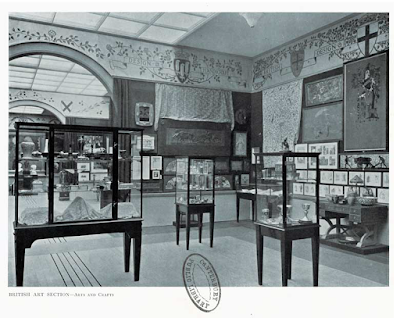In 5 December 1906 there is an article in Evening Post describing "the room at the Exhibition Art Gallery devoted to craft works. These were sent out by the British Government as examples of the ideals to follow in our struggle for the beautiful...A visit to the wall in the Craft room specially devoted to the craftwork of William Morris, shows his marvellous power over tone applied to textile manufactures, in all its force.
 |
| The British Government Arts and Crafts Exhibit at the New Zealand International Exhibition, 1906 |
"One of his energies was the starting of cottage weaving, now carried on by Godfrey Blount, an architect, of Hazlemere (sic), a village in Surrey, Mr Edmund Hunter, of the Edmunds Association of Weavers, and others. They have on view a large and varied collection of hand-woven articles, beautiful in design, in colour and in texture. No. 234 is a hand-spun silk, founded on the thistledown, and has all the lightsome beauty of the down in colouring, and a lightly suggested head of thistledown all over the fabric makes a very fine piece of design. A great deal of the work of the cottage weavers is on view in glass cases about the British sector. Some of these are exceptionally beautiful in texture, and certainly fulfil the adage “that strength and honour are in her clothing.” One especially lifts itself out as more than usually lovely. It is a combination, woven of silk and linen, in flashing grass green colouring, and for perfection has hardly ever been surpassed. These handwoven linens and silks are woven in the cottages of the English villagers by the women themselves. These are for a lifetime. Any housewife who has been lucky enough to own a pair of Irish linen sheets, made by the Irish weavers in their homes, will appreciate what it would mean to have their tablecloths, linen sofa covers, and cream canvas curtains hand-woven.
"All of these articles are shown here, the produce of spare time in quiet English villages. The men are away working all day, and the Peasants’ Arts Society have endeavoured, with what seems astounding success, to put artistic craft into the hands of the cottagers, and at the same time to put money into their pockets. ..There is another, door-hanging, hand woven, No. 347, with a design of a vine intertwined with the grapes, and a flying bird. This shows how it is possible to harmonise contrasting colour. The colour scheme is a deep olive-green, deep scarlet, deep blue, and deep organe, and in the hands of any one but an artist, such a combination would have made the hanging a thing of horror, a nightmare, where this is quiet and harmonious. This was designed by Edmund Hunter and woven by the St Edmund’s Weavers Society.”
Christchurch City Libraries (here) describes the 1906 Exhibition thus "The art exhibition proved hugely popular, attracting one and a half million visitors. "To a great many New Zealanders the British Art display… was the most attractive section of the Exhibition". It was gratifying, the Press enthused, that New Zealanders should have the opportunity to see the largest art exhibit ever shown by the Mother Country at an international exhibition...The exhibition of British art at the International Exhibition was the first major collection of non-colonial art seen in New Zealand. The collection "was one of the most perfect … ever sent from Great Britain, and by far the finest ever shown in a British colony"...
"An important Arts and Crafts section, with 690 works by 171 artists, was put together by Walter Crane and Alfred Longden. This section included furniture and furnishings, textiles, jewellery, metalwork, book bindings, glass, ceramics, mosaics, wood carvings, silver and illuminations. Nearly half the exhibitors were women, including the only New Zealander, Alice Beatrice Waymouth of Christchurch who exhibited art jewellery work and sold 8 pieces.
The New Zealand Government paid for the collection of the works, packing, insurance, transportation and the cost of installation, a total of £7126."